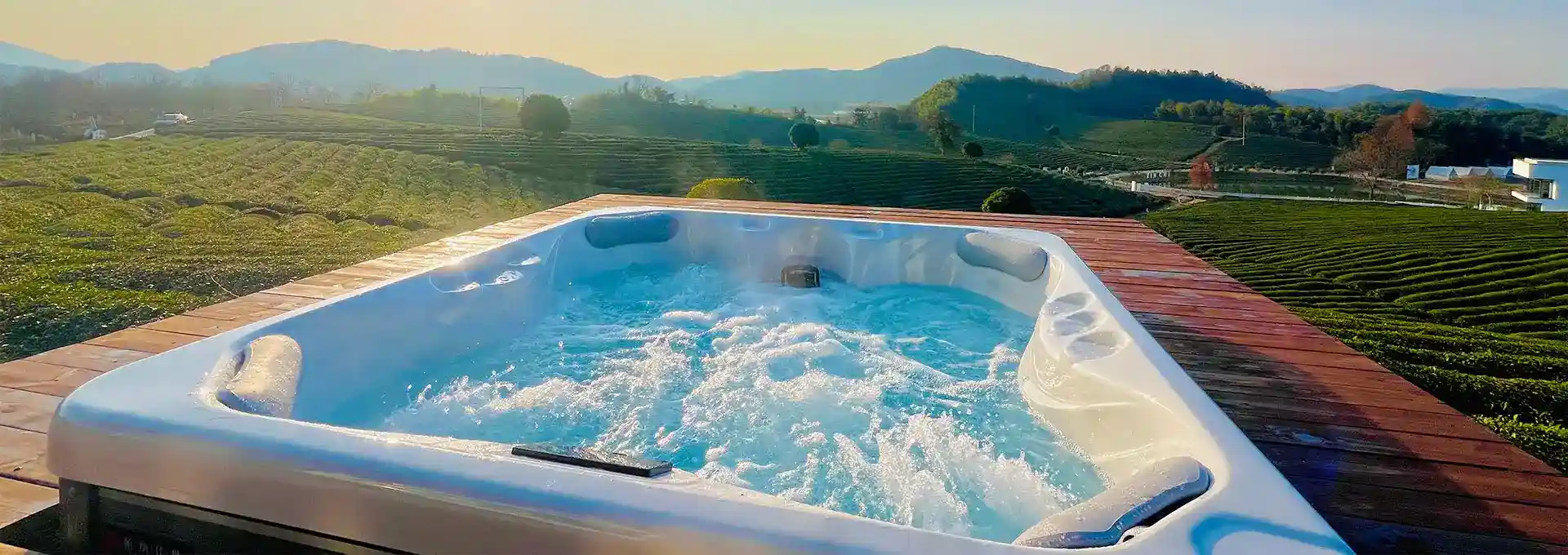What is Normal Hot Tub Temperature?
2024-09-25 09:25:23
Hot tubs are a popular way to relax and unwind, offering a soothing warm water experience for individuals and groups alike. One of the most crucial factors in enjoying your hot tub is setting the right temperature. But what exactly is the ideal temperature for a hot tub? In this article, we'll explore the optimal temperature range for hot tubs and delve into some related questions about 5-person hot tubs, which are a common choice for many households.
How big is a 5-person hot tub?
When considering a hot tub for your home, size is an important factor to take into account. A 5-person hot tub is designed to comfortably accommodate five adults, making it an ideal choice for families or those who enjoy entertaining guests. However, the exact dimensions can vary depending on the manufacturer and specific model.
On average, a 5-person hot tub typically measures between 6.5 to 7.5 feet in length and width. The depth usually ranges from 30 to 36 inches. These dimensions allow for adequate space for each person to sit comfortably without feeling cramped. Some models may be slightly larger or smaller, so it's always best to check the specific measurements of any hot tub you're considering.
The size of a 5-person hot tub also impacts its water capacity. Most 5-person hot tubs hold between 300 to 400 gallons of water. This volume ensures that there's enough water to cover the jets and provide a satisfying soaking experience for all occupants.
When planning for a 5-person hot tub, it's important to consider not just the tub itself, but also the surrounding area. You'll want to ensure there's enough space around the hot tub for easy access and maintenance. A good rule of thumb is to add at least 2 feet of clearance on all sides of the hot tub. This extra space allows for comfortable entry and exit, as well as room for any additional features like steps or towel racks.
The size of a 5-person hot tub also affects its weight. When filled with water and occupied by people, these hot tubs can weigh between 4,000 to 5,000 pounds. This significant weight means that you need to carefully consider the installation location. A solid, level surface is crucial to support the weight of the filled hot tub. Many people choose to install their hot tub on a reinforced concrete pad or a specially designed deck.
Despite their substantial size, 5-person hot tubs are often considered a "goldilocks" option in the world of hot tubs. They're large enough to accommodate a family or a small group of friends, but not so large that they become overwhelming in terms of space requirements or maintenance needs. This balance makes them a popular choice for many homeowners looking to add a hot tub to their outdoor living space.
What is the best temperature for a hot tub in winter?
As the temperature drops outside, many hot tub owners find themselves wondering about the ideal temperature setting for their spa during the winter months. While personal preference plays a significant role in determining the perfect hot tub temperature, there are some general guidelines to consider when using your hot tub in colder weather.
For most people, the ideal hot tub temperature in winter falls between 100°F and 104°F (37.8°C to 40°C). This range provides a comforting contrast to the chilly air while still being safe for most users. The upper limit of 104°F is set by the U.S. Consumer Product Safety Commission as the maximum safe temperature for hot tubs, so it's important not to exceed this temperature.
During winter, many hot tub users prefer to set their tub at the higher end of this range, around 102°F to 104°F (38.9°C to 40°C). The cooler ambient air temperature makes these higher water temperatures feel particularly soothing and can help to warm you up quickly after being in the cold.
However, it's important to note that everyone's tolerance for heat is different. Some people may find temperatures above 102°F too hot for comfortable soaking, especially for extended periods. It's always a good idea to start at a lower temperature and gradually increase it to find your personal comfort zone.
When using your hot tub in winter, it's crucial to keep the cover on when the tub is not in use. This helps to maintain the water temperature and reduces energy costs. Modern hot tubs are well-insulated and designed to operate efficiently in cold weather, but keeping the cover on when not in use can significantly reduce heat loss.
Another consideration for winter hot tub use is the duration of your soak. While it might be tempting to stay in the warm water for extended periods when it's cold outside, it's generally recommended to limit hot tub sessions to about 15-20 minutes. This helps prevent overheating and dehydration, which can be particularly important in winter when you might not feel as thirsty.
If you're using your 5-person hot tub for winter entertaining, you might want to consider setting the temperature slightly lower, around 100°F to 101°F (37.8°C to 38.3°C). This can be more comfortable for a group of people and allows for longer soaking times without overheating.
It's also worth noting that maintaining your hot tub's temperature in winter doesn't have to be energy-intensive. Many modern hot tubs come with energy-efficient features like improved insulation and smart heating systems that help keep operating costs down, even in cold weather.
Remember, while a hot tub can be a wonderful way to enjoy your outdoor space in winter, it's important to prioritize safety. Always enter and exit the hot tub carefully to avoid slips on icy surfaces, and be sure to stay hydrated. With the right temperature setting and proper precautions, your 5-person hot tub can be a delightful winter retreat for you, your family, and your friends.
How much electricity does a 5-person hot tub use?
One of the most common concerns for potential hot tub owners is the impact on their electricity bill. The energy consumption of a 5-person hot tub can vary depending on several factors, including the model's efficiency, your usage patterns, and your local climate. However, we can provide some general estimates to give you an idea of what to expect.
On average, a modern, energy-efficient 5-person hot tub uses between 1,500 to 2,500 kilowatt-hours (kWh) of electricity per year. This translates to about 125 to 210 kWh per month. To put this into perspective, the average American household uses about 877 kWh per month, so a hot tub could increase your electricity usage by roughly 14% to 24%.
The actual cost of running your hot tub will depend on your local electricity rates. As of 2021, the average residential electricity rate in the United States was about $0.14 per kWh. Using this average rate, we can estimate that running a 5-person hot tub might cost between $210 to $350 per year, or about $17.50 to $29 per month.
However, it's important to note that these are just averages. Your actual costs could be higher or lower depending on various factors. For instance, if you live in an area with particularly high electricity rates or extreme weather conditions, your costs might be on the higher end. Conversely, if you have a highly efficient hot tub model or live in a moderate climate, your costs could be lower.
One of the biggest factors affecting energy consumption is the temperature at which you maintain your hot tub. Every degree you raise the temperature increases energy consumption by about 10%. This is why it's important to find a balance between comfort and energy efficiency when setting your hot tub temperature.
Another significant factor is how well your hot tub is insulated. Modern, high-quality hot tubs often come with superior insulation that can significantly reduce heat loss and, consequently, energy consumption. Some models even use the heat generated by the pump motors to help warm the water, further improving efficiency.
The frequency of use also plays a role in energy consumption. Contrary to what you might expect, using your hot tub more frequently can actually be more energy-efficient. This is because it takes less energy to maintain a constant temperature than to repeatedly heat up a cooled-down tub.
To minimize electricity usage, there are several steps you can take:
1. Use a well-fitting, insulated cover when the hot tub is not in use to reduce heat loss.
2. Set the temperature a few degrees lower when you're not planning to use the tub for extended periods.
3. Regularly maintain your hot tub, including cleaning or replacing filters and checking for leaks.
4. Consider using a timer to run the filtration cycles during off-peak electricity hours.
5. If you're in the market for a new hot tub, look for energy-efficient models with good insulation and smart heating systems.
It's worth noting that while the electricity usage of a 5-person hot tub is not insignificant, many owners find that the benefits of relaxation, stress relief, and family time outweigh the additional energy costs. Moreover, when compared to the cost of regular visits to a spa or gym with hot tub facilities, a home hot tub can potentially save money in the long run.
In conclusion, while a 5-person hot tub does use a considerable amount of electricity, the exact usage and cost can vary widely based on numerous factors. By choosing an energy-efficient model and implementing smart usage habits, you can enjoy the benefits of your hot tub while keeping energy consumption and costs under control.
For more information on hot tub installations and to find out more about our products, please feel free to contact us at info@iparnassus.com.
References:
1. U.S. Department of Energy. (2021). Savings Project: Lower Water Heating Temperature.
2. Energy.gov. (2022). Energy Saver: Hot Tub & Pool Energy Efficiency.
3. Spa Depot. (2023). Hot Tub Electricity Usage & Costs.
4. Hot Spring Spas. (2024). Hot Tub Temperature Guide.
5. Home Advisor. (2023). How Much Does a Hot Tub Cost to Run?
6. Consumer Reports. (2022). Hot Tub Buying Guide.
7. U.S. Energy Information Administration. (2024). Electric Power Monthly.
8. Pool Research. (2023). Hot Tub Dimensions: What Size Do You Need?
9. Swim University. (2024). The Complete Guide to Hot Tub Maintenance.
10. Better Homes & Gardens. (2023). How to Choose the Right Hot Tub for Your Backyard.



